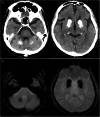Idiopathic basal ganglia calcification presenting with obsessive-compulsive symptoms: A case report
- PMID: 38868467
- PMCID: PMC11114289
- DOI: 10.1002/pcn5.166
Idiopathic basal ganglia calcification presenting with obsessive-compulsive symptoms: A case report
Abstract
Background: Idiopathic basal ganglia calcification (IBGC), also known as Farh's disease, is a rare neurodegenerative disorder characterized by calcification of the basal ganglia and other brain regions. This disease usually occurs in middle-aged patients and presents with various neurological and psychiatric symptoms. The exact prevalence is unknown; however, population genomic data analysis suggests a prevalence of at least 4.5/10,000 to 3.3/1000, indicating that the disease is more common than previously thought and remains underdiagnosed.
Case presentation: We report the case of a middle-aged Japanese man who attempted suicide twice because of obsessive-compulsive ideation caused by trivial triggers. The patient's psychiatric symptoms resolved relatively quickly after hospitalization, and imaging and genetic testing led to a diagnosis of IBGC.
Conclusion: This case report illustrates the importance of including IBGC in the differential diagnosis of psychiatric symptoms that initially develop in middle-aged patients.
Keywords: Fahr's disease; idiopathic basal ganglia calcification; obsessive‐compulsive symptoms.
© 2024 The Authors. Psychiatry and Clinical Neurosciences Reports published by John Wiley & Sons Australia, Ltd on behalf of Japanese Society of Psychiatry and Neurology.
Conflict of interest statement
The authors declare no conflict of interest.
Figures



Similar articles
-
Idiopathic basal ganglia calcification presenting as schizophrenia-like psychosis and obsessive-compulsive symptoms: A case report.Exp Ther Med. 2015 Aug;10(2):608-610. doi: 10.3892/etm.2015.2525. Epub 2015 May 27. Exp Ther Med. 2015. PMID: 26622362 Free PMC article.
-
Fahr's Disease With Late Onset: A Case Report.Cureus. 2022 Mar 19;14(3):e23316. doi: 10.7759/cureus.23316. eCollection 2022 Mar. Cureus. 2022. PMID: 35464530 Free PMC article.
-
[Idiopathic bilateral basal ganglia calcification (Fahr's disease) presenting with psychotic depression and criminal violence: a case report with forensic aspect].Turk Psikiyatri Derg. 2014 Summer;25(2):140-4. Turk Psikiyatri Derg. 2014. PMID: 24936761 Turkish.
-
[Molecular mechanism of idiopathic basal ganglia calcification].Yi Chuan. 2015 Aug;37(8):731-40. Yi Chuan. 2015. PMID: 26353387 Review. Chinese.
-
Sepsis Unmasking Fahr's Disease.Am J Med Sci. 2020 Oct;360(4):406-409. doi: 10.1016/j.amjms.2020.05.023. Epub 2020 May 21. Am J Med Sci. 2020. PMID: 32593413 Review.
References
-
- Kobari M, Nogawa S, Sugimoto Y, Fukuuchi Y. Familial idiopathic brain calcification with autosomal dominant inheritance. Neurology. 1997;48:645–649. - PubMed
-
- Kim S‐H. Familial idiopathic striopallidodentate calcifications. J Korean Neurol Assoc. 2003;21:191–194.
-
- Nicolas G, Charbonnier C, Campion D, Veltman JA. Estimation of minimal disease prevalence from population genomic data: application to primary familial brain calcification. Am J Med Genet, Part B. 2018;177:68–74. - PubMed
-
- Özer Ü, Görgülü Y, Güngör FC, Gençtürk M. Idiopathic bilateral basal ganglia calcification (Fahr's disease) presenting with psychotic depression and criminal violence: a case report with forensic aspect. Turk Psikiyatri Derg. 2014;25(2):140–144. - PubMed
-
- Bozkurt B, Bulakci M, Kilic A, Tatli B, Alyanak B, Oguz F, et al. Fahr disease (idiopathic basal ganglia calcification). J Child. 2011;11:90–93.
Publication types
LinkOut - more resources
Full Text Sources
